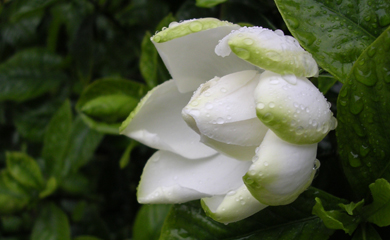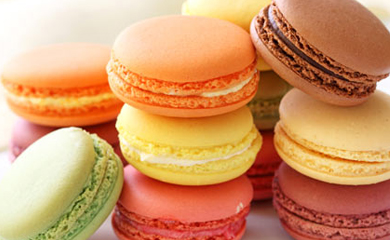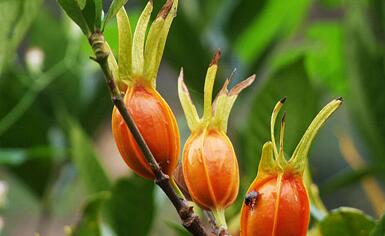Planting history and classification of Gardenia
Gardenia is originated from Central China, and now is widely cultivated around the world. China has a long history in terms of gardenia cultivation. It first appeared in the book Sheng Nong's Herbal Classic, and was named Mudan. In Han Dynasty, Sima Xiangru wrote in his Ode to Shanglin that “there were fresh branches and yellow gravel”, in which the “fresh branches” are actually gardenia trees. In the book the History of the Han Dynasty, it mentioned that “there were gardenia gardens in Han Dynasty”, and in the Book of Jin, it stated that “in Jin Dynasty, there were gardens of gardenia trees, now many palaces have autumn gardenia”. Thus it can be seen that garden cultivation of gardenia has a history of more than two thousand years in China.
In the book Tang Materia Medica, gaedenia tree was called “Zhizi”. Li Shizhen wrote in his book Compendium of Materia Medica that “zhi, a kind of drinking vessel, gardenia fruit looks like it, so it is named zhi”. The ancient medical book Commentaries on the Illustrations wrote that “gardenia can be seen throughout west Sichuan, and the leaves are thick and hard, look like plum tree leaves; it has white flowers during February to March with fragrance, and it has fruits in summer and autumn, unripe in green while ripe in yellow, and the center is deep red.” So, we can see that gardenia trees at that time were widely cultivated throughout the south. It is said that there are red gardenia flowers, and this can be found in the book Flower Border, which wrote that “in the past, Meng Xu held a feast in the fragrant garden in October, and appreciated red gardenia flowers whose fresh fragrance was like plum blossom, but nowadays, it’s seldom to see such kind of gardenia.” Today, if there is red gardenia in Sichuan, then it can be regarded as treasures. It can be seen that there were a lot of garden varieties in ancient China.
Nowadays, all gardenia trees cultivated around the world were introduced from China directly or indirectly. Gardenia was introduced to Japan as early as in the 6th and 7th Century, while in 17th, 18th Century, it was introduced to Europe, arousing widespread interest from local gardeners and flower lovers; then, in early 19th Century, it was introduced to the United States. With continuous breeding in China and around the world, now many new varieties have emerged, such as multi-petaled winter blooming variety, perpetual blooming potting variety, varieties for cut-flowers, as well as monopetalous and multi-petaled varieties with yellow and white spots on the leaves. Abundant varieties have greatly enriched people's lives.
Gardenia is divided into three categories: flower gardenia, water gardenia, and mountain Gardenia.
Flower gardenia: belongs to Rubiaceae gardenia, and likes warm and moist environment. Purpose: flowers can be used as spices or scented tea, and as ornamental, which are excellent fragrant flowers. The origin is Jiangxi, Yunnan, etc.
Water gardenia: alias-sparrow tongue gardenia, belongs to Angiospermae, about 2m in height, multi-branches, with long oval fruit-flat and large. Purpose: extraction of pigment, it also has the function of clearing heat and cooling blood, dispelling mild wind and relieving pain. Origin: Guangxi and Fujian.
·Mountain gardenia: a kind of Rubiaceae plant and evergreen shrub with oval or nearly spherical fruit, 0.5-2m in height; containing flavonoid gardenin, pectin, crocin, crocetin, D-mannitol, nonacosane, beta sitosterol, etc. It also contains several kinds of glucoside: gardenoside, genipin-1-glucoside, pureonebio--1-β-D-gentiobioside, and samll amount of shanzhiside. Purpose: stems and leaves can be used as medicine to cure fever-caused annoyance, liver heat caused red eyes, headache, sprain swelling and pain, etc. Origin: Henan, Hubei, Zhejiang and other places.
- RecommendRead
-

19th Food Ingredient
2016-12-25 -

14th Food Ingredient
2016-12-25 -

The company attende
2016-12-25 -

The company attended
2016-12-25 -

Warm congratulations
2016-12-25